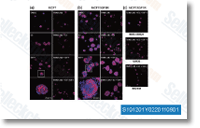In help of our hypothesis, PKC?shRNA cells had ele vated costs of protein synthesis established by phenylalanine incorporation. accompanied by lowered IRS1 serine1095 phosphorylation following four days of differentiation. On the other hand, myogenic events are probable independent of insulin receptor sig naling due to the fact its tyrosine phosphorylation was decrease in PKC?shRNA cells in spite of greater differenti ation, fusion, and protein synthesis. Additionally, IRS1 phosphorylation at tyrosine 1222 was reduced in PKC?shRNA myotubes.Additionally, phosphorylation of AKT, a kinase activated in response to IRS1 PI3 kinase signaling. was not distinct be tween cell types at serine 473, yet was diminished in PKC?shRNA myotubes at threonine 308. Lastly, phosphorylation of mammalian target of rapamycin at serine 2448, a downstream target of AKT, was also reduced in PKC?shRNA day four myotubes.
Collectively, our protein synthesis and immunoblot information suggests involvement of a mechanism apart from the ca nonical IRS1 PI3 kinase AKT signaling pathway in professional moting differentiation, fusion and protein synthesis in PKC?shRNA cells. MAPKs take part in the regulation of the plethora of cellular functions, like the proliferation and selleck inhibitor vary entiation of muscle cells as well as the modulation of IRS1 sig naling. Especially, ERK1 two expression increases for the duration of differentiation of C2C12 cells and permits the ex pression of myosin hefty chain. Additionally, ERK5 regulates myogenesis within a pathway independent of that, which activates MyoD, and MEF2 regulated genes. Moreover, MEK1 two is known as a beneficial selleck MLN0128 regulator of the muscle specific transcription element MyoD whose expression is needed for your initiation of myoblast differentiation. ERK also reciprocally signals to IRS1.
In 3T3 L1 cells, IRS1 serine 636 639 phosphorylation triggers IRS1 degradation which can be dependent on MEK1 two induced ERK activation in human skeletal muscle cells. Last but not least, in myeloma cells, ERK is phosphorylated through an IRS1 dependent mechanism. Within this research, complete IRS1 protein amounts have been markedly decreased in PKC?shRNA cells with each other with greater phosphorylation of serine 632 635 in day 4 myotubes,  suggesting ERK dependent signaling. As anticipated, ERK1 two phosphoryl ation was enhanced in PKC?shRNA cells. Although ERK5 has been demonstrated to also regulate fu sion of C2C12 muscle cells. a difference in ERK5 phosphorylation in between PKC?shRNA and scramble cul tures was not detected. Whilst phosphoryl ation websites on ERK5 besides people analyzed right here contribute to cell development an survival in other cell forms, these web pages have been shown regulate mitotic activity rather than terminal differentiation. Interestingly, mTOR is recognized like a substrate for ERK. and mTOR is required for the fusion of differentiated skeletal muscle cells.
suggesting ERK dependent signaling. As anticipated, ERK1 two phosphoryl ation was enhanced in PKC?shRNA cells. Although ERK5 has been demonstrated to also regulate fu sion of C2C12 muscle cells. a difference in ERK5 phosphorylation in between PKC?shRNA and scramble cul tures was not detected. Whilst phosphoryl ation websites on ERK5 besides people analyzed right here contribute to cell development an survival in other cell forms, these web pages have been shown regulate mitotic activity rather than terminal differentiation. Interestingly, mTOR is recognized like a substrate for ERK. and mTOR is required for the fusion of differentiated skeletal muscle cells.
Met Receptor Signal
Cancer stem cells are thought to hijack the ability of normal stem cells to express MET.
